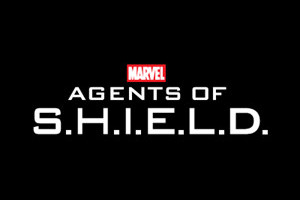
The Marvel universe is filled with so many characters and organizations that it is easy to get lost. When we factor in the differences between the comics and the Marvel Cinematic Universe, the order of events can become almost mind-boggling! One of my readers left this comment in an earlier post: “I’ve often heard of S.H.I.E.L.D. but have no idea what it stands for.” This is understandable. Often titles like this are just complacently used, and it is expected that we should know what it means. An example of this is the TV show NCIS starring Mark Harmon. The show premiered on April 22, 2003. NCIS is an acronym for Naval Criminal Investigative Service. I was 45 years old when this show began, and I had never heard of NCIS. I always thought it was interesting when the NCIS agents would question someone and say, “I’m agent DiNozzo with NCIS” or yell, “Stop! NCIS!” If they had been questioning me, I would have said, “NC what?” But the people in the show just nodded knowingly. How many were like me that didn’t have any idea who NCIS was?
But I digress. This post is about S.H.I.E.L.D. In the MCU, S.H.I.E.L.D. is a backronym for Strategic Homeland Intervention, Enforcement and Logistics Division. That’s a mouthful! In the 2008 film Iron Man, a conversation between Pepper Potts and S.H.I.E.L.D. agent Phil Coulson went like this:
“I’m Agent Phil Coulson with the Strategic Homeland Intervention, Enforcement and Logistics Division.”
“That’s quite a mouthful.”
“I know. We’re working on it.”
“You know, we’ve been approached already by the DOD, the FBI, the CIA…”
“We’re a separate division with a more specific focus.”
Later, when Pepper tries to repeat the entire title, Coulson interrupts and says, “S.H.I.E.L.D.”
This secret organization became an integral part of the super heroes’ story, so it is time we take a look at how it started. As with the stories of the characters, S.H.I.E.L.D. finds its beginning in the comics. So the comics will be the focus today as we answer the question: What is the history of S.H.I.E.L.D. in Marvel Comics?
S.H.I.E.L.D. was first introduced in a long-running anthology series
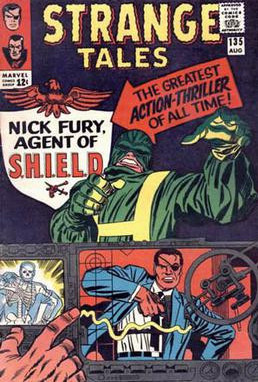 Just like many of the super heroes’ in Marvel Comics, S.H.I.E.L.D. was introduced in Strange Tales. The issue was #135 (August 1965) and was created by Stan Lee and Jack Kirby. This issue was titled “Nick Fury, Agent of S.H.I.E.L.D.” and came out during a trend for action series about secret international intelligence agencies with catchy acronyms. In a 2014 interview, Stan Lee stated that the television series “The Man from U.N.C.L.E.” was the basis for him to create the Marvel organization. Colonel Fury was first introduced in Marvel’s World War II series Sgt. Fury and his Howling Commandos in a cover dated May 1963. In this new series, he is re-imagined as slightly older with an eye patch (which he didn’t have in WW II) and appointed head of the organization. Some characters from the Sgt. Fury series were now introduced as agents of S.H.I.E.L.D., most notably Timothy “Dum-Dum” Dugan, Fury’s aide-de-camp.
Just like many of the super heroes’ in Marvel Comics, S.H.I.E.L.D. was introduced in Strange Tales. The issue was #135 (August 1965) and was created by Stan Lee and Jack Kirby. This issue was titled “Nick Fury, Agent of S.H.I.E.L.D.” and came out during a trend for action series about secret international intelligence agencies with catchy acronyms. In a 2014 interview, Stan Lee stated that the television series “The Man from U.N.C.L.E.” was the basis for him to create the Marvel organization. Colonel Fury was first introduced in Marvel’s World War II series Sgt. Fury and his Howling Commandos in a cover dated May 1963. In this new series, he is re-imagined as slightly older with an eye patch (which he didn’t have in WW II) and appointed head of the organization. Some characters from the Sgt. Fury series were now introduced as agents of S.H.I.E.L.D., most notably Timothy “Dum-Dum” Dugan, Fury’s aide-de-camp.
Their main adversary was Hydra which was ultimately revealed to have been formed by recurring villain Baron Wolfgang von Strucker. Strucker would be killed off shortly after appearing in the strip, but the character would be brought back to life in the 1989 Nick Fury series decades later. Other adversaries that made an appearance were AIM (a mad scientist guild that was part of Hydra before splintering off), and mercenary spies such as the Fixer and Mentallo. Stories were serialized, lasting several issues each.
From it is very first introduction in Strange Tales, the organization was presented as a full-blown entity with Tony Stark in charge of special weaponry, and Fury seeing “some of the most famous joes from every nation” at a meeting of the Supreme International Council (Strange Tales, #135, The Man for the Job). As we will see, much was revealed over the years about the organization’s history.
Stan Lee himself wrote each story with plotting expertise of Jack Kirby through Strange Tales #152, except for two issues, one scripted by Kirby (#148) and one by Dennis O’Neil (#149). Issue #153 was written by Roy Thomas and #154 was co-written by Thomas and new series artist Jim Steranko. Then came the sole-writer debut of Jim Steranko, who quickly established the feature as of comics history’s most groundbreaking, innovative and acclaimed. Steranko took Jack Kirby s dynamics and embedded them with the graphic influences of Peter Max, Op Art, and Andy Warhol. He designed the pages as a whole, not just a series of panels, making each page crisp and overflowing with drama. The series won 1967 and 1968 Alley Awards and was inducted in 1968 to the awards’ Hall of Fame. Steranko was inducted into the Comic Book Hall of Fame in 2006.
Nick Fury received his own series in 1968
Nick Fury, Agent of S.H.I.E.L.D. continued in Strange Tales up through issue #168. During that time, it shared a “split book with the occult feature Dr. Strange. After issue #168, it was spun off into its own series of the same name. This series would only last for fifteen issues (June 1968 – November 1969), and Steranko would only write and draw issues #1-3 and #5 and draw the covers of #1-7. He was not able to keep to the deadlines for a 20-page issue. 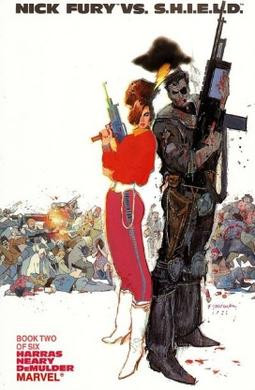
It would be nearly two decades after the first solo issue before new stories would appear. Next up would be a six-issue miniseries Nick Fury vs. S.H.I.E.L.D. (June – November 1968), followed by Nick Fury: Agent of S.H.I.E.L.D. (vol 2), which lasted for 47 issues (September 1989 – May 1993).
The organization is mentioned in other Marvel story lines, but below is a list of other series that are primarily focused on S.H.I.E.L.D.:
Fury of S.H.I.E.L.D. – premiered in 1995
Kitty Pryde, Agent of S.H.I.E.L.D. – premiered in 1997.
S.H.I.E.L.D.– two series. The first published June 2010, details the secret history of the occult organization S.H.I.E.L.D. aka “The Brotherhood of the Shield.” The second series premiered with first issue cover dated December 2014 and was loosely based on the TV series “Marvel’s Agents of S.H.I.E.L.D.” It was superseded by Agents of S.H.I.E.L.D.
Howling Commandos of S.H.I.E.L.D. – premiered in 2015.
Nick Fury was not the first director – early history of S.H.I.E.L.D.
When the secret organization first began, the backronym stood for Supreme Headquarters, International Espionage and Law-Enforcement Division. It started off as a top-secret international organization, proposed by American business and weapons manufacturer Howard Stark, a member and agent of the Brotherhood of the Shield. He proposed the idea to a group of U.S. government officials who decided to officially start Project: S.H.I.E.L.D. At that time, they even considered C.I.A. agent Nick Fury for the position of Executive Director. Stark’s organization was then formed, being sponsored by the U.S. government, the United Nations and Stark Industries. Its first director was Rick Stoner, former head of the C.I.A. The very existence of S.H.I.E.L.D. was made public when Stoner was apparently killed by Hydra operatives, prompting the President of the United States to recommend Nick Fury to take the role. Up to this point, Fury had been unaware of S.H.I.E.L.D. while he was in the C.I.A. Later on in Nick Fury vs. S.H.I.E.L.D.#1 (June 1988), it was revealed that the ultimate authority of S.H.I.E.L.D. was a cabal of 12 mysterious men and women who gave Fury his orders and operational structure, while leaving Fury to manage the actual implementation of the orders.
The first dismantling of S.H.I.E.L.D. occurred after an infiltration of the agency by LMDs (Life Model Decoys) that had attained sentience. The decoys had infiltrated both S.H.I.E.L.D. and Hydra, replacing key leaders before being defeated by Fury and his allies. The reorganized agency was backed by the United Nations, with the backronym now standing for Strategic Hazard Intervention, Espionage and Logistics Directorate. This new S.H.I.E.L.D. was designed to be more streamlined so Fury could personally oversee it, but it would soon become large again.
The spy agency had distinctive equipment
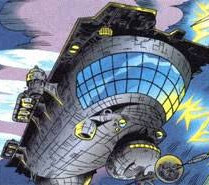 The writers’s imaginations were the limit when it came to giving the agency its iconic equipment. They were equipped with flying fortresses known as Helicarriers which served as mobile headquarters for the organization. Other vehicles included hover filers, flying cars and tunneling vehicles. Fury’s weapon of choice was a 300-round .15 caliber pistol specially designed to fire explosive-tipped needles. Tear gas boutonnieres, explosive shirts, rear view periscope hats, camera-phone watches, jet packs, cigars laced with various chemical compounds, and other tools of the spy trade insured that S.H.I.E.L.D. agents were prepared with the right equipment. The LMDs (mentioned above) were actually an invention of S.H.I.E.L.D. designed to emulate the behavior of an individual and were usually used to replace someone in danger of being killed. During the Cold War, the agency also maintained a large headquarters in New York City, as well as in every major city in the Western world, and hidden outposts in many communist countries.
The writers’s imaginations were the limit when it came to giving the agency its iconic equipment. They were equipped with flying fortresses known as Helicarriers which served as mobile headquarters for the organization. Other vehicles included hover filers, flying cars and tunneling vehicles. Fury’s weapon of choice was a 300-round .15 caliber pistol specially designed to fire explosive-tipped needles. Tear gas boutonnieres, explosive shirts, rear view periscope hats, camera-phone watches, jet packs, cigars laced with various chemical compounds, and other tools of the spy trade insured that S.H.I.E.L.D. agents were prepared with the right equipment. The LMDs (mentioned above) were actually an invention of S.H.I.E.L.D. designed to emulate the behavior of an individual and were usually used to replace someone in danger of being killed. During the Cold War, the agency also maintained a large headquarters in New York City, as well as in every major city in the Western world, and hidden outposts in many communist countries.
This is just the tip of the iceberg (so to speak)
How can we really exhaust the information about such a huge organization and years of storytelling in just one blog post? I have only touched on a small framework as we looked at the history of S.H.I.E.L.D. I hope this gives you a bit of an understanding of the agency. Maybe it will leave you wanting more. I know there is so much more we can uncover. Who were the agents? How does the comics version differ from the MCU?
Thank you for reading. Leave your comments below and suggest other post ideas with questions you would like to have uncovered. Be sure to check out my other posts!
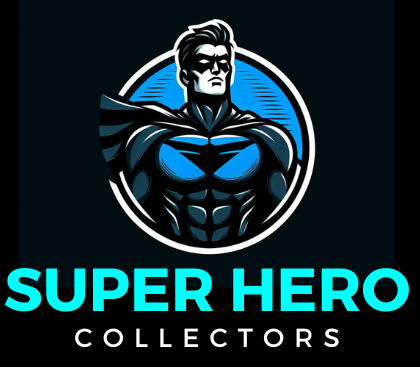
The history of S.H.I.E.L.D. is long and has some major twists in it. I was a fan of the comic when it came out but have since fallen in love with the cinematic versions. I believe there is more room for more plot twists and turns. Unfortunately, Stan Lee is no longer with us, maybe we can find someone who is as brilliant as he was.
Jerry
Jerry, thank you for your input! I hope you will come back and read more content. I will definitely write about MCU as well as comics!
I’ve always been a fan of the Marvel Cinematic Universe. In fact I’d say that movie wise they’re some of my favorite movies and I’ve watched all of them. That’s why I was always curious about what role S.H.I.E.L.D played in the MCU and I feel a lot more informed than I used to be on this matter. What I found most interesting is that Nick Fury wasn’t the first director… the movies for sure make it seem that this is the case so I guess you can say I’m a little surprised. As a side note I hope Marvel movies improve b/c they haven’t been as good in my opinion recently. Anyway now I feel obligated to watch the Agent of Shield tv show
Thanks for your comments! Marvel’s Agents of Shield is a great show! I think I’ve watched all 7 seasons 3 times and learn something new every time. I hope you come back and read more of my content!
As i remember marvel comics were page turner. when i was reading the topic the word S.H.I.E.L.D was so confusing. S.H.I.E.L.D. is a backronym for Strategic Homeland Intervention. I’m big fan and i watch them all.I found out too many interesting datas. its so useful to assign time to know this kind of hints better because Marvel studio is such a huge organisation.
I am a fan of Shield but never in my imagination did i think it can be dated back as far as 1965. From the full name , i now see why alot of the stories is centered on intelligence and investigation. It is a lot good to dig down deep into history. Thank you for this detailed work. Its such a mind opener and an enlightening article
Parameter – thank you for stopping by and commenting on my post. I’m glad you enjoyed it. You might also enjoy my other posts about super hero history. Please stop in again and leave a comment or question. 🙂
It was only after starting to read your blog, that I became aware of the difference between the comics and the Marvel Cinematic Universe. And now learning that S.H.I.E.L.D. is more a focus in Marvel comics, is another eye-opener.
Once again you have excelled in your explanation of what does S.H.I.E.L.D. stand for and the history of it. I often wonder how much of the adventures are based on fiction, and how much might be real security issues? It would be interesting to know.
I’m glad you got to read and comment again on my post. Thank you for your kind words. It would be very interesting to know if any of these are real security issues. I’ll have to look into it. Thanks again!
Thanks for an interesting read into such a rich historical comic S.H.I.E.L.D.
This reminds me of how obsessed we become with comics and their characters, movies, and toys. These have worldwide presence that continues to entertain us and provide an outlet for our imaginations.
Where is the agency currently at now? Are new comics being written or developed anywhere in the world? What was the most popular time for this agency and the marvel comic?
Thank you for a rich informative read
Thank you for stopping by! Those are some great questions for future posts for me! Have you watched Marvel’s Agents of S.H.I.E.L.D.? It’s a very exciting series that lasted for 7 seasons. It will give you a sense of where they are now, although it is different from the comics. The MCU is always different.
Hi Scott,
Thar brings me back to childhood when I was a big time fan of Marvel Comics. Indeed, S.H.I.E.L.D. has been in existence since 1965!
Ultimately I now know what S.H.I.E.L.D. stands for but ask me to repeat- that would be a mouthful!
Great to track back the origin. I feel so connected with S.H.I.E.L.D. now.
Thanks for sharing this great article.
Regards,
Rohit
Thank you for stopping by and taking the time to comment. I’m glad you enjoyed the read. Please check out some more of my superhero content. I think you may find some interesting reads.
I’ve admired the Marvel Cinematic Universe from the beginning. I’d even say they’re some of my favorite films overall, and I’ve seen every single one of them. I was always interested in the role S.H.I.E.L.D. played in the MCU because of this, and I now feel much more knowledgeable about it than I did before.
Thanks for this post:)
S.H.I.E.L.D.’s role in the MCU is quite different from the comics. The MCU has the Avengers being an initiative of S.H.I.E.L.D. but in the comics the Avengers were started before the agency ever came along. With that said, I loved following them in the MCU. I especially enjoyed the 7 seasons of Marvel’s Agents of S.H.I.E.LD. I’ve watched the entire thing 3 times! You can find the show in Disney+. Also, if you liked the movies, you might enjoy my post on watching the Avengers movies in chronological order. We did that a couple of years ago and it was a lot of fun.
Thank you for stopping in and commenting. I’m glad you liked the post!
S.H.I.E.L.D. has a lengthy and eventful history. At the time of the comic’s release, I enjoyed it; however, I now prefer the film adaptations. I’m a huge fan, and I’ve seen them all. So much fascinating information was uncovered by me. Considering the scope of Marvel Studios, it’s really worthwhile to set aside some time to familiarize oneself with these kinds of recommendations.
Thank you for stopping by to comment! I hope you can check out some more of my super hero content. I have a post about the Avenger movies.
I just finished reading the article about the history of S.H.I.E.L.D. in Marvel Comics and I have to say, I am thoroughly impressed by the depth and breadth of the information provided. The article did an excellent job of tracing the evolution of S.H.I.E.L.D. over the years, highlighting the key events and characters that have shaped the organization.
I also appreciated the attention given to the various iterations of S.H.I.E.L.D. in different media, as this helped to give a more complete picture of the organization’s role in the Marvel universe.
Overall, this was a great read and I will definitely be keeping this article in mind as I continue to explore the world of Marvel Comics. Thank you for sharing this valuable information!
Lorenz, I am glad you enjoyed this article! I hope you come back and read more comic history. There is more to come! In the meantime, please check out my other articles that I recently published. – Scott
Great explanation with an example of how to determine what S.H.I.E.L.D. means by using one of my favorite shows NCIS. I have now learned from your explanation of what S.H.I.E.L.D. means and doesn’t mean just some kind of body armor to protect their characters’ bodies from other enemies’ power sources. The Strategic Homeland Intervention, Enforcement, and Logistics Division is a lot to say, and would like to know more about how the comic book writer taught this.
HI Jannette! thank you for stopping by and reading another post about Marvel comics. I’m thrilled that you are enjoying this content and I hope you continue to visit my site. – Scott
I have been a comic book fan as well as an artist since I was a kid and it’s amazing how some these characters even the ones who are the least popular have a whole back story to them. When I watch a lot of comic book movies they will introduce a character I know nothing about thinking that they were just someone just put someone in the movie but I later learn that these people have a backstory that was created by their creator as though they were real people.
Thank you for reading and commenting! Please come back and check out other great content as I explore other characters.